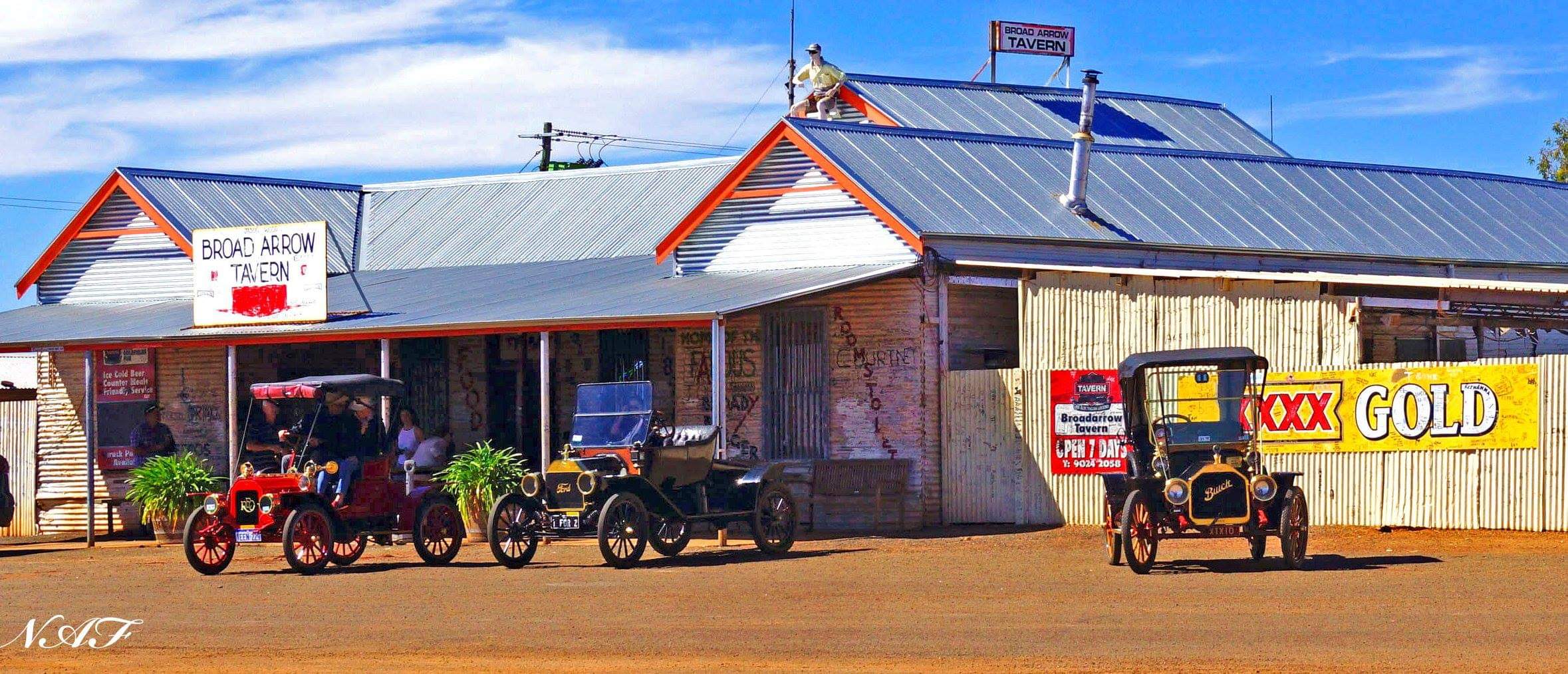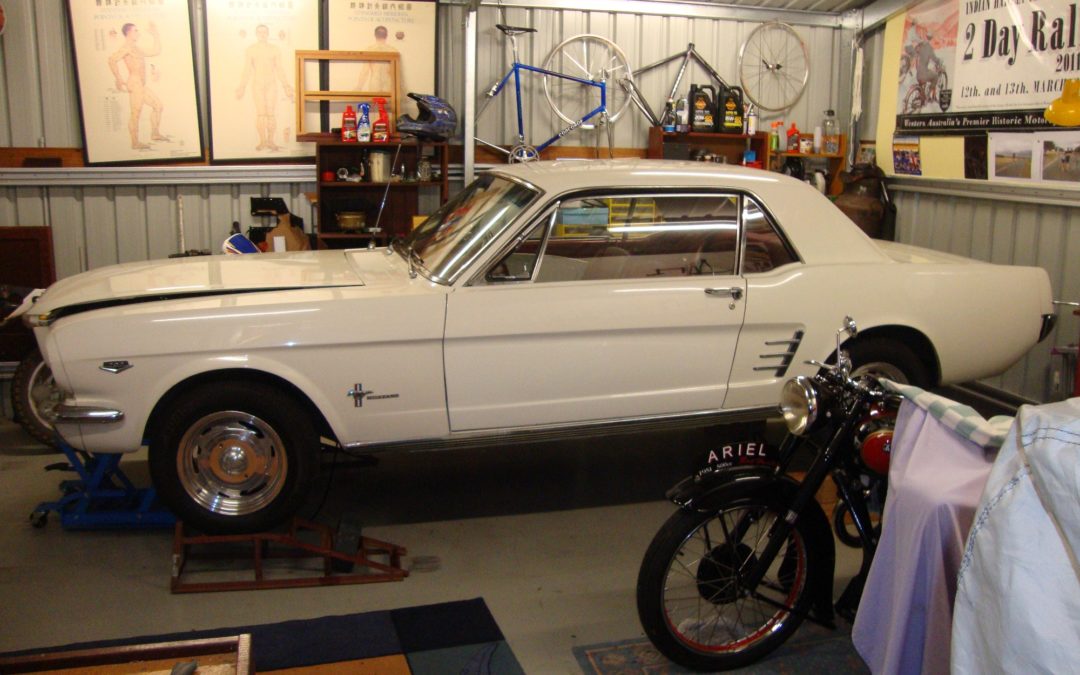
by Dan Talbot | Feb 11, 2019 | Projects
As we begun to scratch the surface, it was evident all was not well beneath the shiny white exterior of our Mustang coupe.
After the transmission and engine were removed from my Mustang I (quite mistakenly) figured I could tackle the rust and body work in my shed. I had done it before with my Studebaker, and an XJ6 Jaguar before, that so I began to strip the paint of the worst areas.
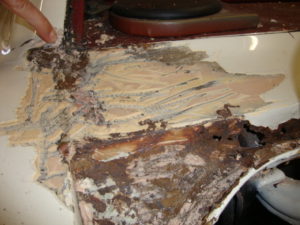
Scratch below the surface and dirty, rusty metal was evident all through the car.
The paintwork looked okay and polished up well but there were tell-tale rust bubbles in all the usual places where water and moisture can gather. What I was unaware off was the extent of that rust. As I stripped back layers of paint I was confronted great gobs of putty and body filler. It was like removing the layers of a rotten onion, including the tears. In some places the body filler was over half an inch thick! Whoever prepared the car for paint on a previous occasion clearly had the skills of Rodin. To have so much bog caked on the car and actually have it look like a Mustang was quite remarkable. It should be remembered, now, if you crash your car, you can purchase new body panels from which to repair it with. Back in the sixties and seventies in Australia this was not an option and panel beaters had to live up to their name, hammering out dents and covering their work with body-filler. My car had the scars of many a crash.
By the time I had reached bare metal, panel by panel, I was confronted with bent, buckled and rusty body parts that were good for nothing but the tip. Before I had even a third of the car uncovered I realized I was in over my depth. The job required someone with skills beyond my rudimentary grasp of panel work. A work colleague had an acquaintance that ‘paints cars,’ and took me to meet him.
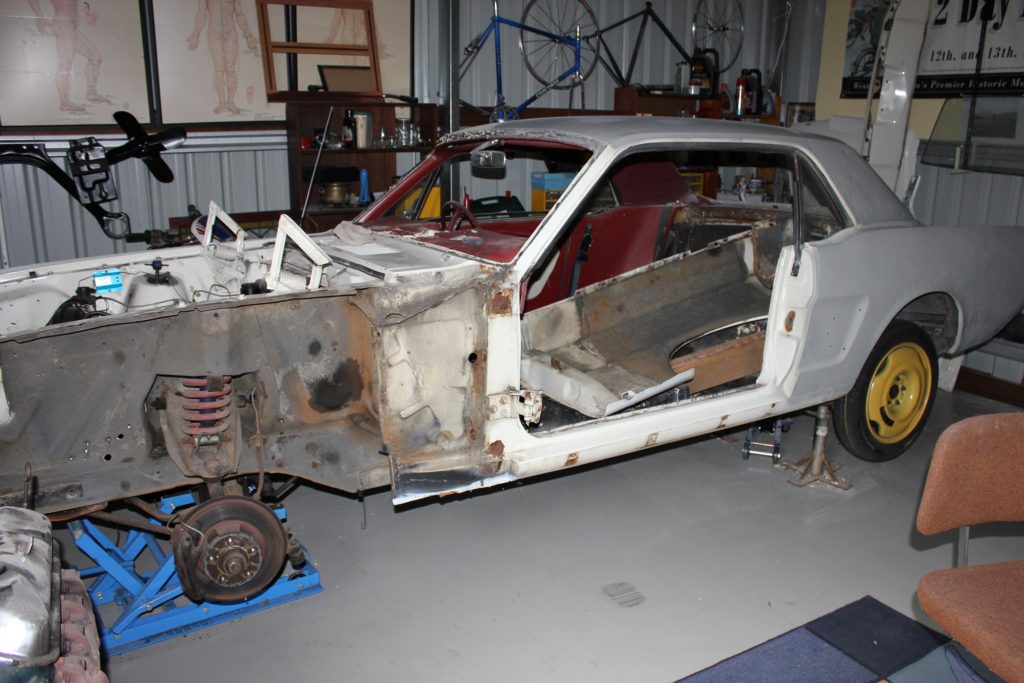
Working at home: it was about now when I realized I had reached the limit of my body building and repairing skills.
On walking into Joe’s workshop I was confronted with an assortment of American and Australian classic muscle cars at various stages of restoration. I knew this was the place for me. It was like stepping into an automotive surgery where valuable, collector cars were given a new lease on life and I wanted to be part off it. I wanted to spend as much time in that place as I was able to so I asked if I could be part of the process and Joe agreed to let me participate in the restoration. I hastily arranged a month’s leave from work and readied myself to become the master’s apprentice.
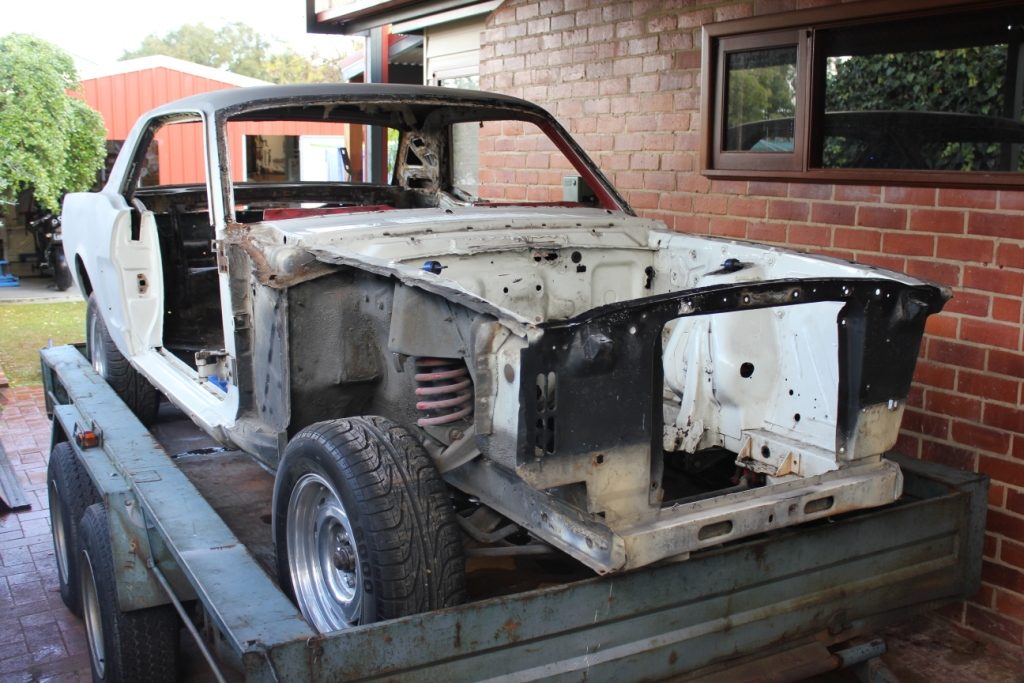
The Mustang is loaded up for transport to a professional, old-school body building workshop to share floor-space with many other classic American and Australian muscle cars.
It would be a few weeks before I could get away from work which gave Joe’s men time to sand blast the rest of the paint and gunk from my Mustang. It wasn’t pretty. In the raw metal, my car was a rusted, holy, twisted wreck that, according to Joe, had, “more hits than Elvis.” It would require just about every panel to be replaced. This hurt. Firstly, emotionally but later pain would be of the fiscal kind. My wife reads this column (look away now love) and I feel a bit of guilt and anxiety talking about it but Joe estimated it would be between $35,000 and $40,000 to bring my body back to new, therefore, I had to make a decision to continue of cut my losses and get out of the car.
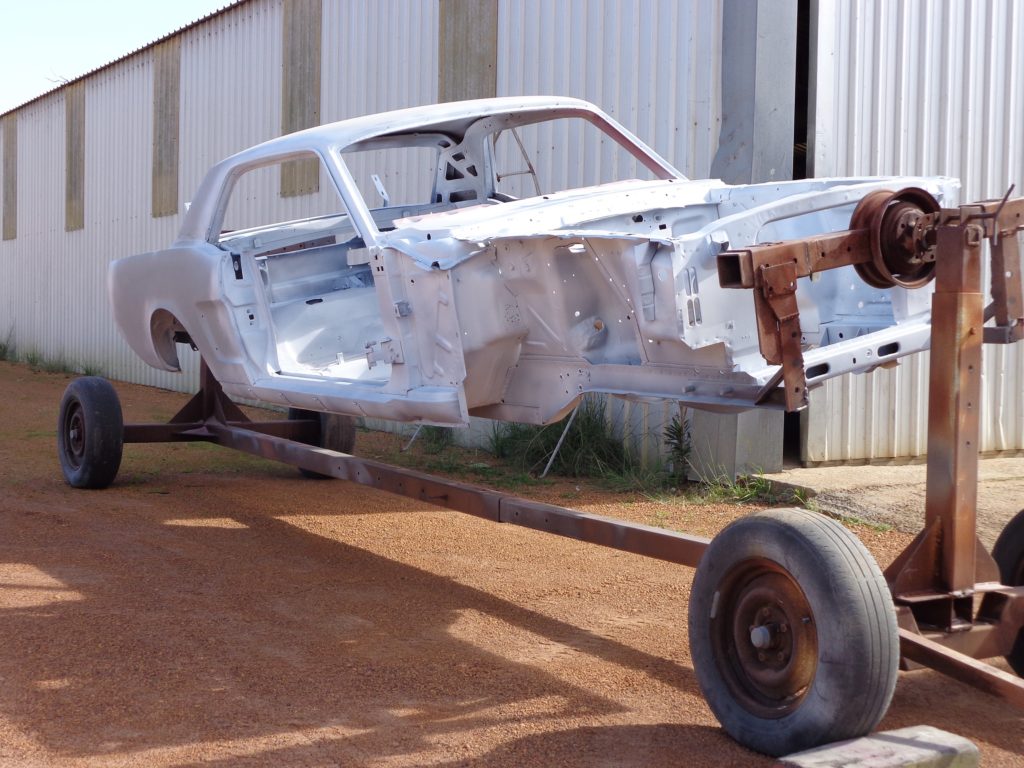
Stripped of paint and filler, the extent of the ‘damage’ could be measured. Do we stay or do we go? We opted to push on.
I was in too deep. I had paid over $20,000AUD for my Mustang so the show had to go on. Added to this, the car had provenance, apart from being an original Ford Australia Mustang, the first owner was and Australian touring car champion (who, for the time being, shall remain nameless). Joe said “it’s not going to be cheap, but you will have a brand new body.” That was enough for me, “let’s get cutting.”
The body was welded to a sturdy steel base to prevent it folding in half as we cut it down to a mere skeleton.
Then we went into Joe’s office and he opened up Mustang body parts supplier and began clicking on the pieces we would need;
- Floor,
- Doors,
- Bonnet,
- Boot lid,
- Rear quarter panels,
- Rear parcel tray,
- Rear wheel tubs,
- Tail light panel,
- Rockers panels,
- Rear deck,
- Rear wheel tubs,
- Wiper cowl,
- Lower wiper cowl, and
- Front radiator mount.
That was just to get us started, there would be a few more panels yet before the project saw a primer coat. Joe simply looked at the price of the panels and said “I can’t fix yours for that,” as he clicked each panel into the computer shopping basket before heading back into the workshop to begin cutting all the pieces or junk metal from the body.
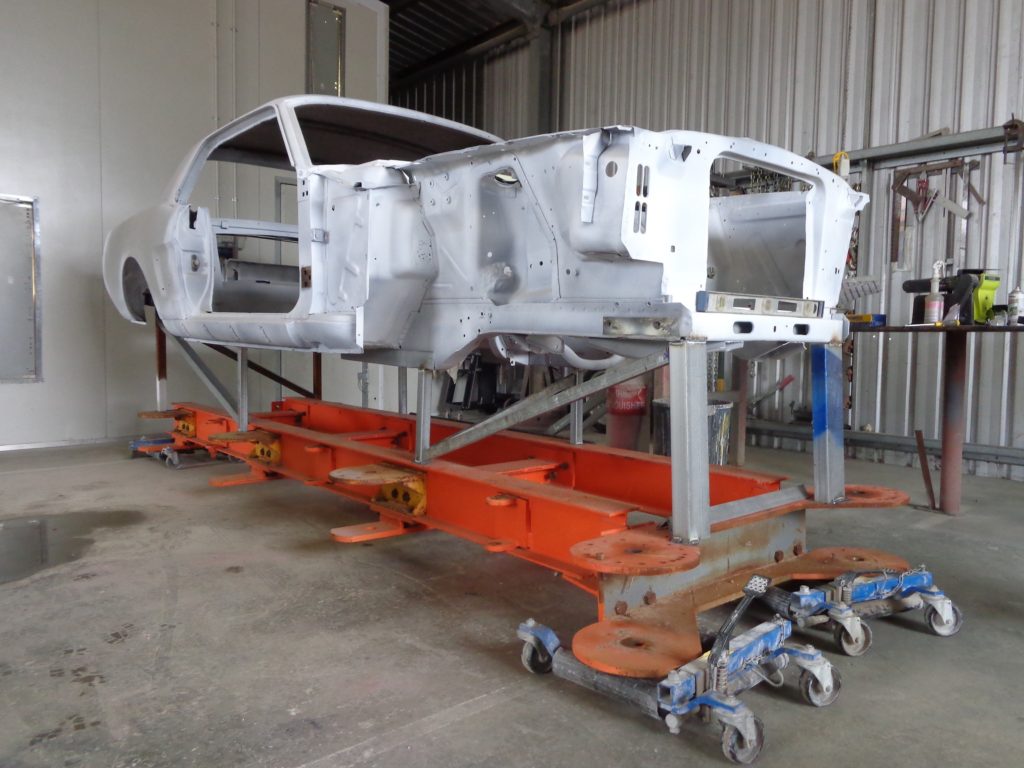
Before getting started, it was necessary to secure the body to a firm base. We were about to remove so much metal from the car it would collapse had it not been properly braced and secured.
After a lesson in the art of cutting spot welds off a seam, Joe handed the oxy torch to me and I got to work cutting panels away. It takes a deft hand to remove the top piece of metal without blowing a hole in the piece below. On those early days I blew lots of holes in the metal that we intended to keep. “Don’t worry, the first 15 years are the hardest,” Joe would say.
At this point, it is worth mentioning not every twisted, buckled panel was cut off the car. For example, the C-pillars, the upright panels that connect the rear of the roof to the body, were heavily battled scared but I chose to leave them in place for a number of reasons. Obviously cost is one part of it and the interior headliner will cover the damaged metal but, more importantly, the dents and crumples represent a life of hard living and hard driving. Like the craggy face of a gold-miner who has spent a life under the sun, the character lines stay.
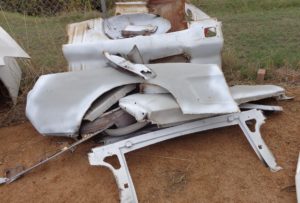
Just some of the parts that we cut off of the car.
Elsewhere, at the front of the car, the workers carrying out the left to right side conversion, hammered massive dents in the right shock tower and chassis rail so they could fit the Fairlane Compact steering box. In anticipation of me fitting a steering rack, Joe said he would get rid of those dents but I insisted they remain. These cars are part of the history of Ford Australia and are very rare. Most of them have been fixed and improved as owners have sort to overcome the idiosyncracies of a fairly rough conversion, including me, however, it may be the case that someone in the future will wish to revert to the car to its original state so it’s important to make sure that’s remains a possibility.
A full discussion of the Homebush Mustangs can be found here ( https://motorshedcafe.com.au/the-homebush-mustang-story/).
What we’ve learnt.
- The better the body is braced, the better it will maintain it’s original integrity – no matter how clumsy you are.
- Rust is a cancer but keep as much original metal as you can.
- Don’t do anything to the car that can’t be undone.
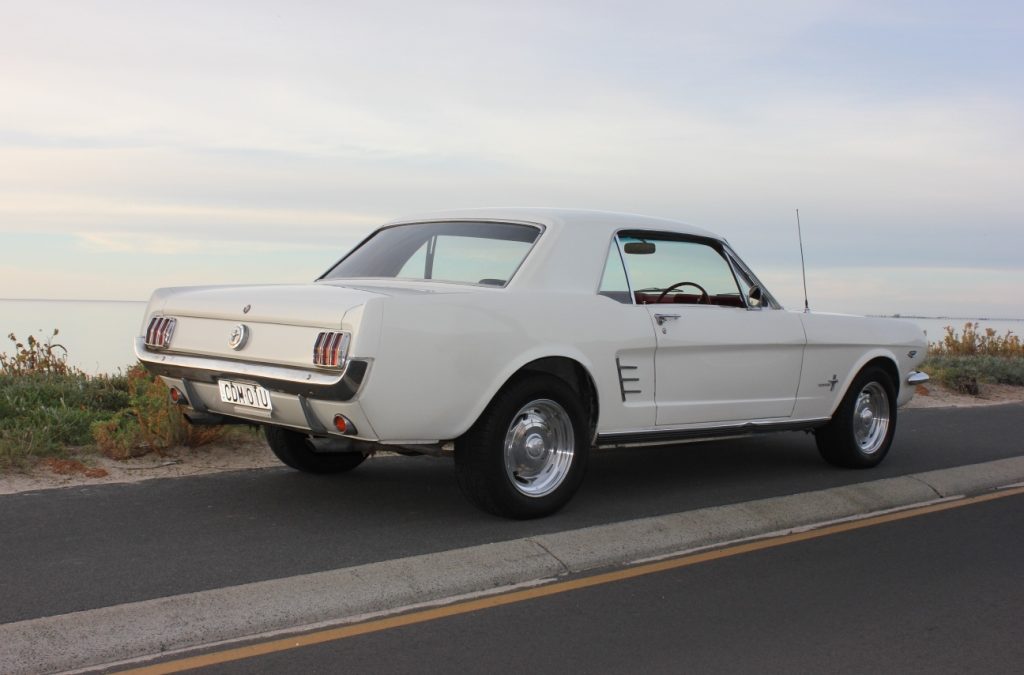
by Dan Talbot | Feb 10, 2019 | Projects
As many readers would know, Homebush is a suburb of Sydney and is not ordinarily associated with the iconic American sports car, but how the Homebush Mustang came into being is an extraordinary tale.
When I started searching for a Mustang I was fairly sure I wanted a right-hand drive car. In the back of my mind I was looking for something that might have made an everyday driver which basically ruled out left hand drive cars. The one I settled for, sight unseen, was advertised as a Ford Australia factory converted right hand drive car. I never knew there was such a thing back in the sixties but if the factory had converted it then it must be a proper job, not some backyard hack that I was learning were all too common.
As we negotiated the sale of the car across the country with telephone and email, it became clear to me the car was not exactly concourse, indeed, it was a bit rough but I figured the money I would save in not having to convert the car to right hand drive would go a long way towards knocking the rough edges off.
Eventually the car was loaded onto a truck and bound for WA. The owner instructed when it arrived the car would start easy enough but the transmission would need to warm up a bit before she would move. The alarmed me a bit. When the fateful day arrived and my alarm only increased. The truck driver said words to the effect, “good luck with this one,” as he unloaded it from his trailer. I could tell she wasn’t about to effortlessly glide off the trailer. It took a lot of revving to finally coax the old girl into moving backwards and down onto the road.
Two immediate observations were the unmistakable lines of the classic, first series Mustang. To my mind then, as now, one of the most beautiful cars on the road. The other thing was the truly sublime rumble coming from the old 289 V8. Modern V8 engines just cannot replicate that sound. When the engine was eventually stopped, it was time for a closer look at my purchase. I popped the bonnet and was immediately confronted by an ugly mess. The engine may have sounded nice but it was in a sad, sorry old state of disrepair. Never mind, I purchased the car as a fixer-upper.
Whilst checking the engine out, I couldn’t help noticing a few oddities about my factory right hand drive conversion. The first thing was the wipers, they had not been moved so the driver only gets half his view wiped when driving in the rain. My immediate thought was “surely that’s not factory.” Turns out it was, but more on that later.
Elsewhere in the engine bay;
- The firewall hadn’t been altered, which forced the brake booster to be located in front of the right-side shock tower.
- The steering box was too large for where it was located which resulted in the right-side shock tower and chassis rail having great dents hammered into them to accommodate the box.
- The was a massive brace extending from each shock-tower back to the firewall. A later learned this was a Shelby Mustang accessory which was also fitted to cars designated for expert, hence it was called an ‘export brace.’ Incidentally, mine was just sitting on the top of the firewall, basically doing nothing.
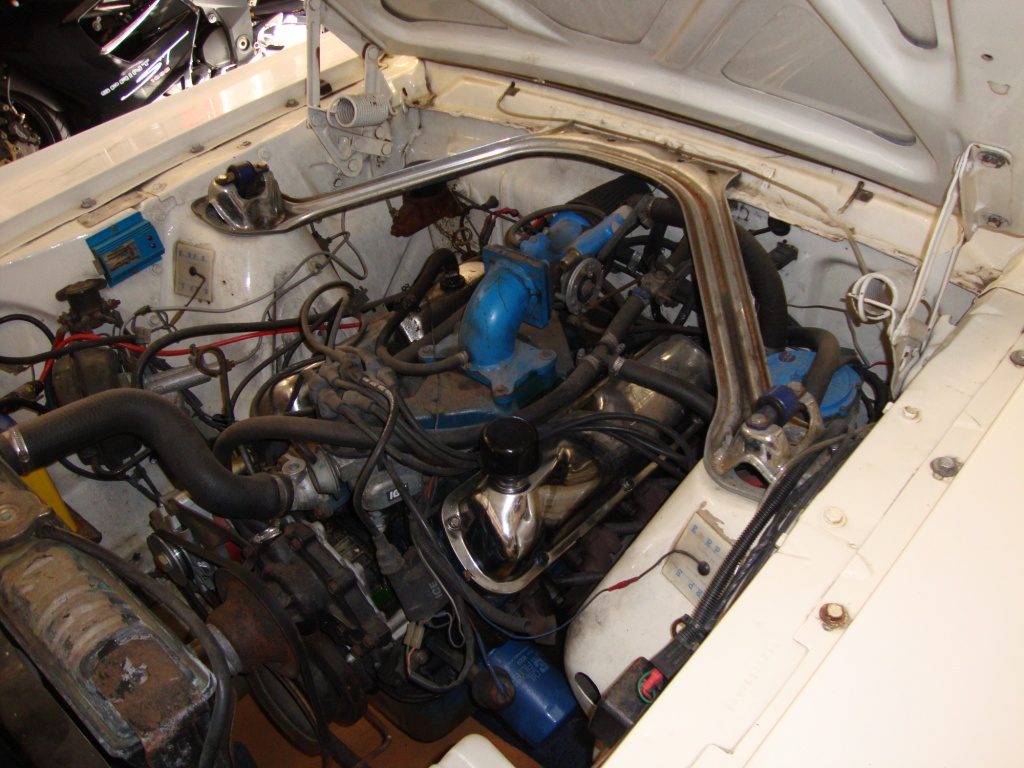
The first time I popped the bonnet on my Mustang gave me a bit of a shock. Note the ‘export brace’ from the shock-towers to the firewall and the remote brake booster in front of the right shock tower.
When I finally got to drive the car, the engine started easily and settled into a smooth tick-over. From the driver’s seat the old 289 sounded orchestral. It was exactly what I had been hoping for. I settled in, selected reverse and waited, and waited. Nothing. Move the T-bar back and forth, yep, that’s reverse but nothing was happening. The engine was still ticking over so I give it a rev and the car responded with the slightest budge – backwards. I revved the engine a bit more and felt the faintest tension play along the drive-line. A few more revs and she began moving out of Laurie’s driveway with all the grace of a cruise liner.
The 60-kilometre drive home filled me with ambivalence. Here I was in my dream car, the car I had been waiting the best part of 40 years to own, an old-school, US muscle car powered by a Ford V8. And it was bloody awful. It wallowed around, the steering was vague and the engine seemed to rev too high for the ground speed.
By the time I got home I had come to terms with much of the car. I also started to do some research about Ford Australia factory converted Mustangs and learned there was a long and complicated history as to how roughly 44, 1965 Mustangs and maybe 161, 1966 cars would come to carry Ford Australia Motor Company of Australia compliance plate, guaranteeing a rare place in Australian motoring history.
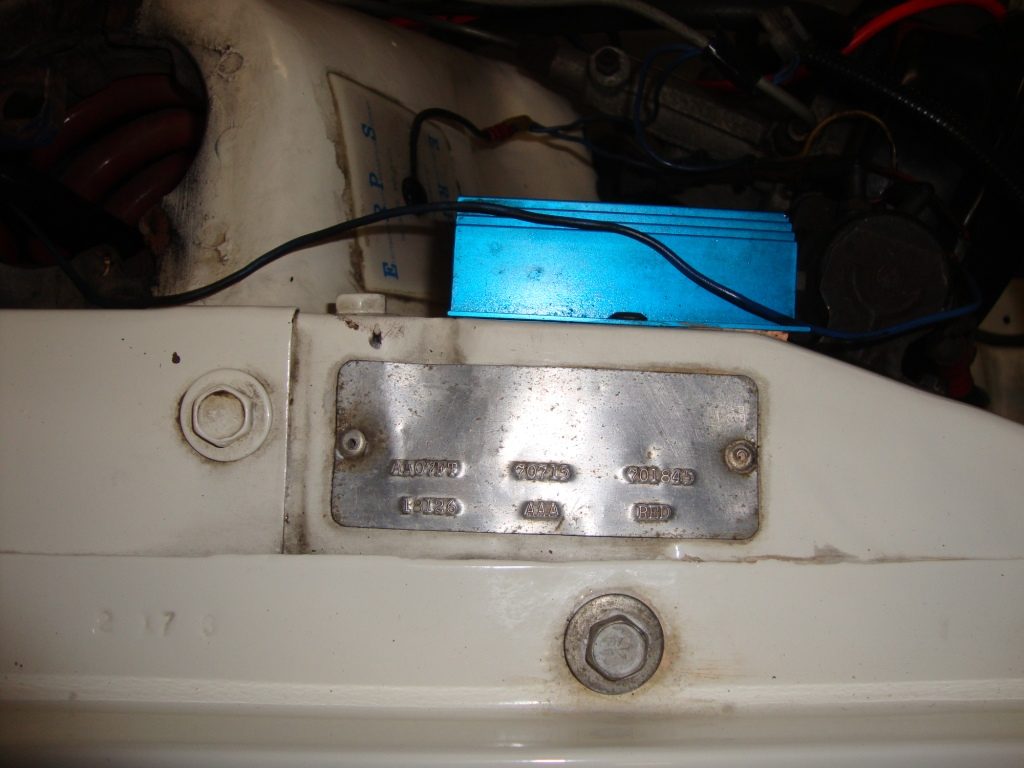
A very old Ford vehicle identification plate on my car confirmed I had purchased a rare piece of Australian motoring history.
I ducked outside, whipped up my bonnet and, sure enough, popped-riveted to the right guard was a small piece of aluminium with numbers pressed into it. All the print had worn off but it was unmistakably a Ford Australia compliance plate. I had a Homebush car!
When the Mustangs started to arrive in the country it became evident that Ford Australia were not equipped to carry out the conversion, in expertise nor facilities. Makeshift workshops were set up first within Ford Australia’s Homebush plant, followed soon thereafter in a factory unit (or units) nearby the plant, thus these unique cars have become referred to as Homebush Mustangs.
In bringing the cars to Australia, it was Ford’s intention to put a Mustang on the floor of all 435 Ford dealerships in the country to promote sales of the soon to be released XR Falcon. Indications were the buying public might not be so accepting of the newly designed Falcon so, in a cleverly designed, if somewhat expensive, marketing campaign, the XR was marketed as “the Mustang-bred Falcon.”
The architect of the Mustang-bred Falcon campaign and, by necessity, the RHD conversion was Ford executive Bill Bourke. Evidently, when it came to introducing the Mustang, Ford Australia’s ambitions raced very much ahead of their abilities and the conversions proved to be far more complex than Bourke anticipated.
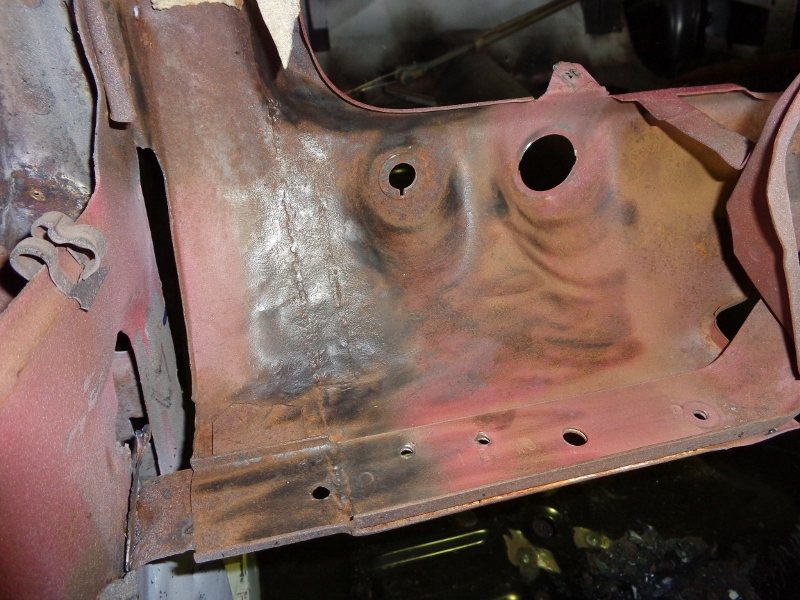
The welds on the converted dash are at least one thing that was done expertly on the Homebush cars.
In getting ready to carry out the conversions Bourke arranged to have a number of newly-pressed, replacement dashboards airfreighted to Australia ahead of the arrival of the cars. This proved to be a wise move as the panels were not symmetrical and some fancy, old-school metal work was required to change them from left to right. Contractors were employed to undertake the work and everybody basically got to work by trial and error (some would say more error than trial!).
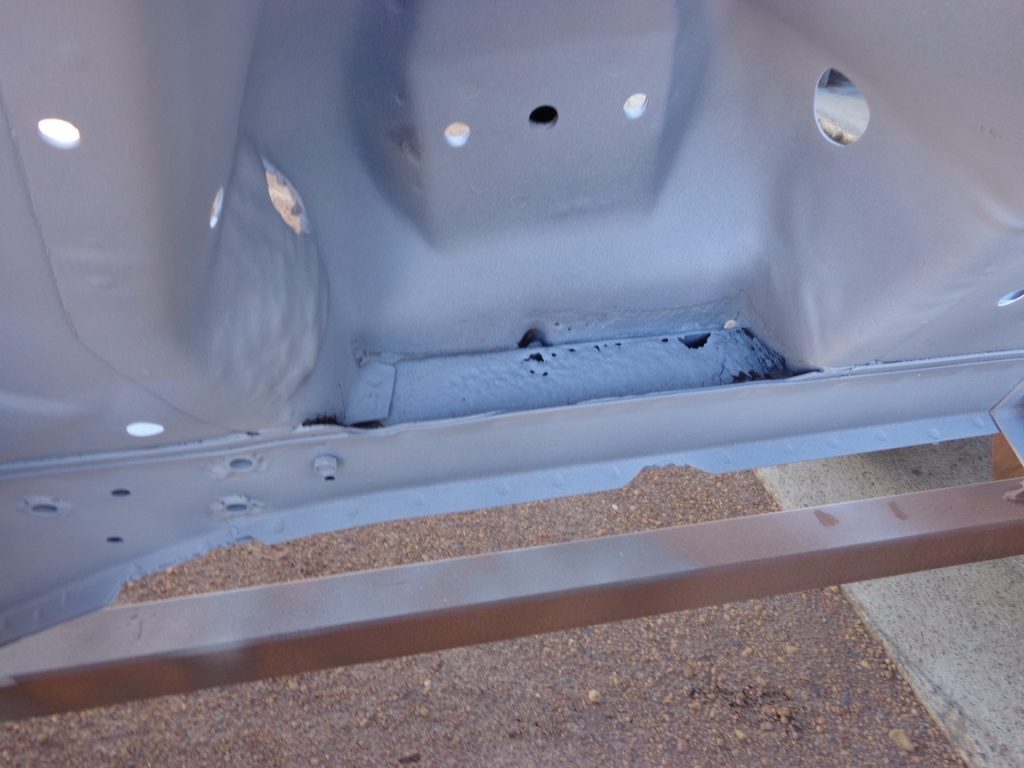
The big bulge to the left of the picture was hammered there by the Homebush engineers to allow the RHD Ford Fairlane Compact steering box to be fitted to the Australian cars.
A major challenge to the conversion was the fire-wall. In standard form, the firewall bulges out on the right side to accommodate the Mustang heater box. This presented a couple of problems. Firstly, the heater had to be removed and an alternative sourced. Secondly, the bulge was right where the brake power-booster would ordinarily go. The first item was solved by fitting a smaller, Falcon XP/XM heater box. The second by relocating the brake booster to the front of the engine bay. It looks a bit cobby, but in the interests of keeping things authentic, I stuck with having the booster up forward. I could have replaced the firewall with a brand-new, right-hand drive panel but again this would have detracted too much from the authenticity of my original Homebush car.
As it was, there was no fix for the steering setup that was contained within my car. The steering box has been confined to storage and replaced with a rack and pinion set up manufactured by RRS in Sydney. To maximise the RRS rack I have also fitted their coil-over suspension and larger disc brakes. I’ve yet to drive the car with the modern equipment in it but I’m confident she will steer and brake with a finesse that was not available to Ford Australia when their men did the best they could in converting what was destined to become an icon of Australian motoring history.

by Dan Talbot | Jan 28, 2019 | Projects
The Motor Shed Mustang has been with us for about six years so updates for this project will look forward and back with equal measure.
In the six years that we have owned the car it has spent a lot of time out of the shed, often by design as things are a bit cramped in there of late. The most recent period of absence was a long one, 18 months to be exact, but the car has recently been returned to the shed with all new brake hydraulics, a wiring harness in place and a 2.5-inch stainless steel exhaust. We are getting very close to registering the car and we are looking forward to sharing the details of the restoration but first let us introduce our 1966 Mustang coupe. You might like to grab a cup of tea and some biscuits because it’s a long story.
Ever since I was a child I longed for the day I would own a Mustang. A trip to the Perth metropolitan area wasn’t compete until I had laid my eyes on at least one Mustang. As I grew older my passions gravitated more towards motorcycles than cars, then, of course, along came kids of my own. One of those kids is my step-son who was fostering his own dreams of owning a special type of car.
Like me, James’ dream car came to prominence through the Australian Touring Car Championships. For me it was the total domination by Mustang coupes at the hands of drivers like Beechy and Geoghegan for five years from 1965 to 1969, for James it was Richards and Skaife in the Nissan Skyline in the early nineties. Funny how history repeats, generations apart.
James was the first to realise his dream of owning a Bathurst-inspired race car. He sourced a well-looked after, 1990 Nissan ‘Godzilla.’ It was a mighty car, I can’t remember driving anything quite as powerful as that Nissan. Sadly, a few too many launch starts took their toll on the highly tuned engine and it developed a terminal knock within about three months of ownership. Rebuilding the engine was cost-prohibitive which left James having to sell the Nissan with a blown engine for about half what he paid for it, which left him with a significant debt and no car. It was a heavy impost for a 20 year old on the minimum wage, but I came up with a plan.
I said, “Listen mate, I’ve always wanted a classic Mustang, you need a car, what about if I buy a project and we can work on it and you can drive it until you get back on your feet then I’ll take it over?”
James’ eyes lit up and together we began trawling the classifieds for a suitable project. It wasn’t long before James noticed all the cars we were looking at were automatics, as a young bloke he was keen to have a manual.
“Sorry mate, it’s an American thing.” I explained.
“Do they have air-conditioning?”
“Probably not.”
“Power windows?”
“No.”
James sat there for a while mulling things over in his head and then said, “Nar, don’t worry about it, they are not my sort of car.”
I was stumped. My Mustang dream had been so close and then it was gone. That’s when his Mum spoke up.
“Darling, if you want a Mustang that bad you should buy one.” I’m back in the game.
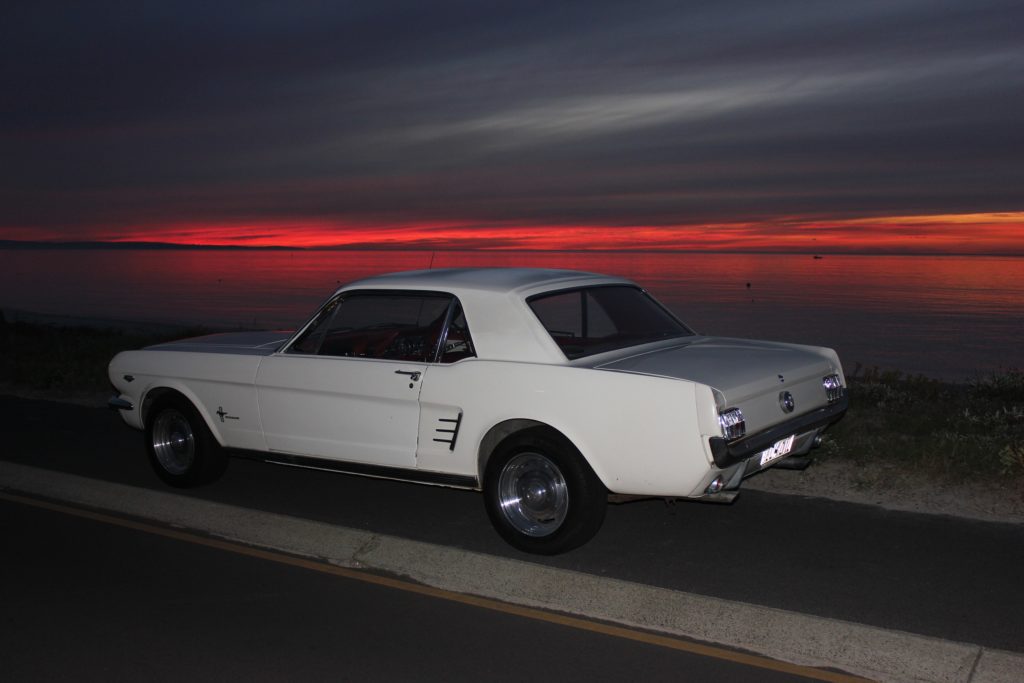
Good from afar, but far from good.
After a couple of false starts, one of which involved a $1,000 deposit going across the country and then back into my account when the owner got a better offer, we finally settled on a 1966 coupe. It had to be a coupe, that’s what Beechy and Geoghegan drove in the touring car championships nearly 50 years before and, by god, that’s what I had to have.
In 1966 Ford Australia was due to release the all new XR Falcon. It was a major change in model and early signs were the buying public were not that keen so the Ford Australia marketing department came up with a campaign that connected the new Falcon to the Mustang by introducing the car as the “Mustang bread Falcon.” To sweeten the deal it was resolved to put a Mustang on the floor of each of the 430 Ford Dealerships in Australia, which was no small undertaking as each one of those 430 Mustangs started out as left-hand-drive cars.
To meet the challenge of converting the cars, Ford Australia set up a workshop next door to the Homebush plant in Sydney. Converting the cars proved to be a difficult, expensive task and eventually the idea was shelved, but not before some 200 odd cars were converted. No one is sure of the exact number of Mustangs carry the Ford Motor Company of Australia identification plates but mine is one such vehicle.
I purchased my car sight unseen. I was told by the owner that the car was a factory converted vehicle but, when I first laid my eyes upon it, I felt this surely couldn’t be the case, the conversion was completely agricultural. If I thought the conversion looked rough, the drive was even worse.
One of the defining features of Falcons of the sixties and seventies is the feel of the steering. It was much better than the equivalent offered by Holden and Chrysler but my Mustang was simply awful to steer. Added to this, the transmission was slack and spongy. The car was very much a disappointment.
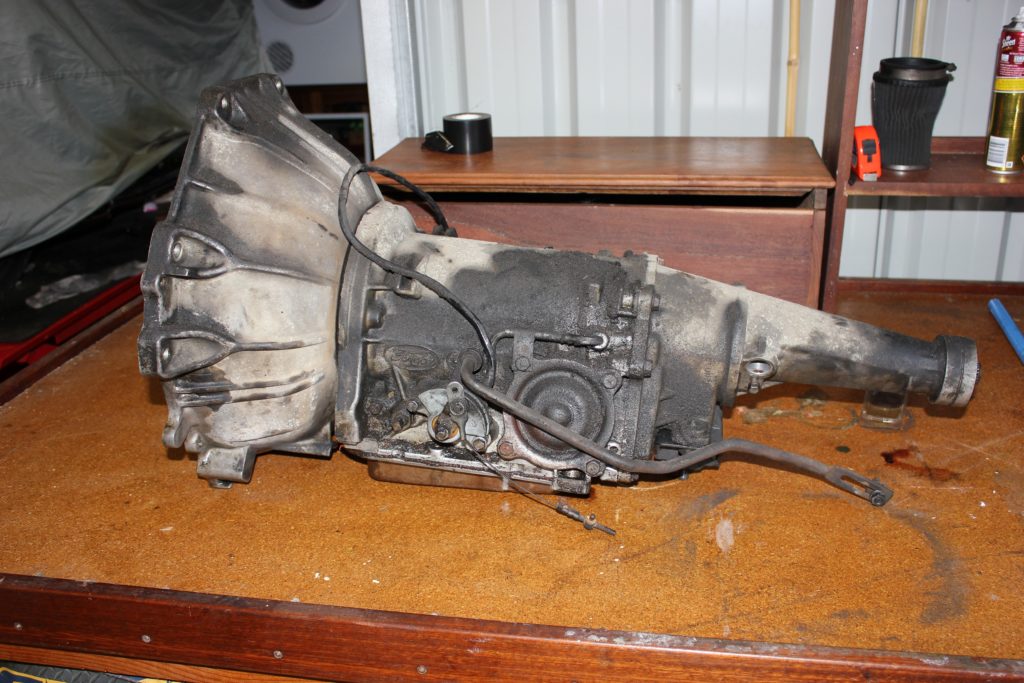
Within a few days of getting my car home I decided I could not live with the slushy transmission. The car was elevated and I took the transmission out, dropping it on my hand in the process. It had been a while since I last removed a transmission so it was with much glee I shouted to my wife as the transmission was slowly lowered toward the floor as I bled the hydraulic trolley jack the tranny was perched upon. At precisely that moment, the transmission got hung up on something and the jack continued to lower. The transmission rolled off the jack and crashed to the floor, my hand was conveniently placed to break the fall. It was one of those moments where I daren’t look at the injury. By the time I did eventually take a peak, the blood had begun to ooze through the black grease that covered the wound. It was a sorry site but I had the transmission out of the car and on the floor – success.
A friend well versed in the art of transmission rebuilds came to my house on two or three occasions, spending about two hours on each visit. Before long the transmission was looking almost new but the engine looked hideous, so I resolved to tidy that up a bit too.
And that’s how things got started!
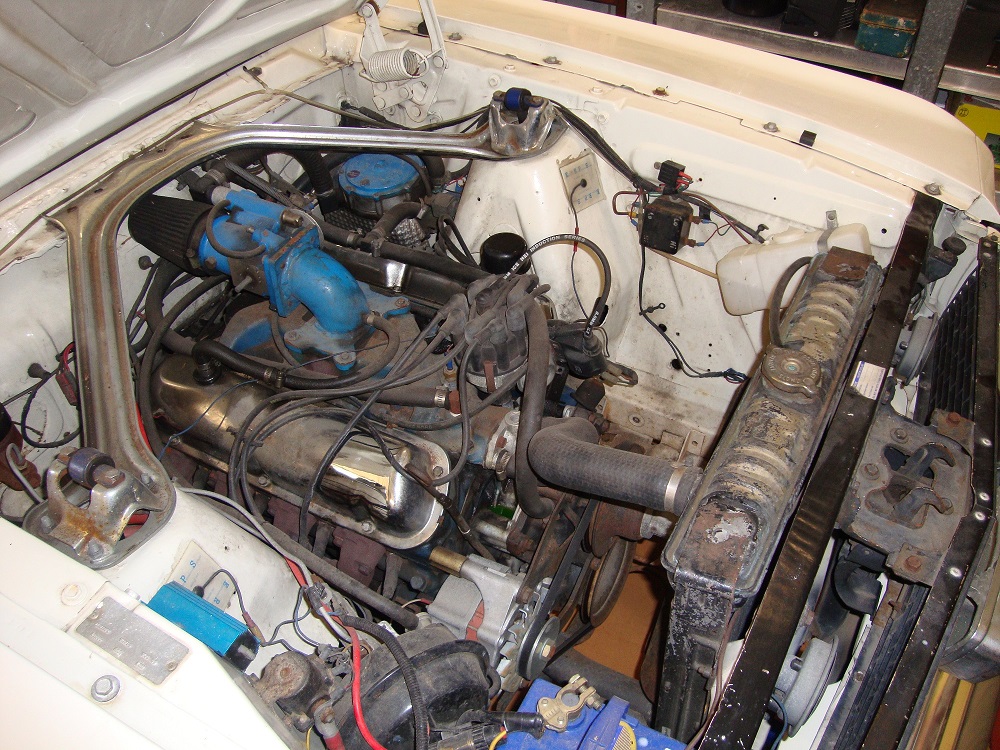
The old Windsor 289 was on dedicated LPG and was a strong runner – she just looked a bit crook so it had to come out.
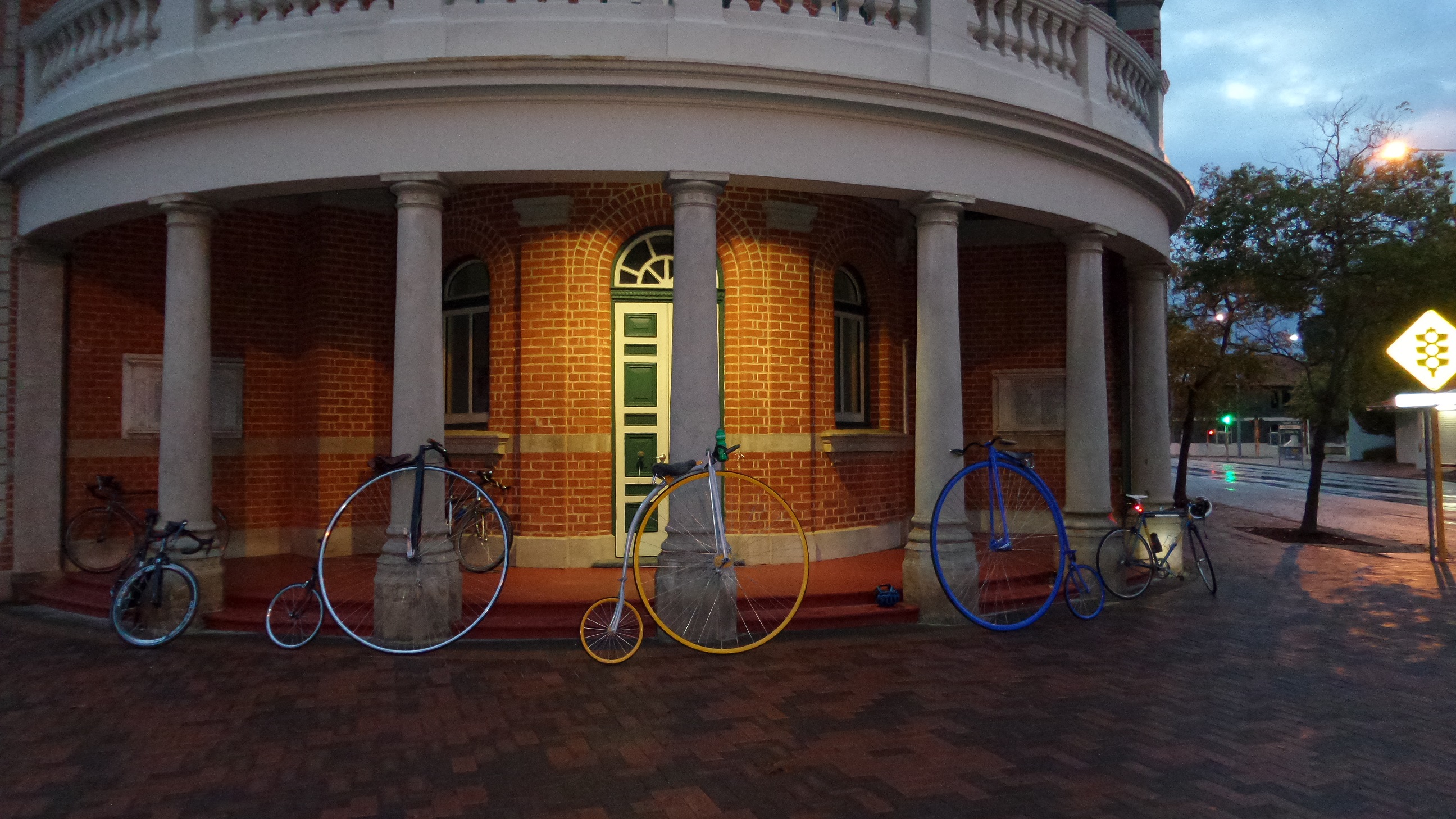
by Dan Talbot | Jan 26, 2019 | Events
We here at the Motor Shed are fond of most things with two wheels, even those which include us as the motor, such as the humble bicycle. This story was first published in Early Auto magazine, the official organ of the Veteran Car Club of WA. It is revisited here as a prelude to us returning to the Goldfields again in 2019 for the Perkolilli Revival.
Robert Pirsig in Zen and the Art of Motorcycle Maintenance, wrote of the sense of presence one experiences when travelling by motorcycle, the scenery no longer passes frame by frame, as if on television. Pirsig explains, “on a cycle the frame is gone. You’re completely in contact with it all. You’re in the scene, not just watching it anymore, and the sense of presence is overwhelming.”
Pirsig’s philosophical discourse on quality has very little to do with cycling but the act of riding his motorcycle allowed Pirsig to gather his thoughts and experience the sense of wellbeing that comes with propelling one’s body through the elements, but, perhaps Pirsig has only half the scene. Remove the engine, the heavy protective clothing, the fairing and helmet and the sense of presence is even more pronounced.
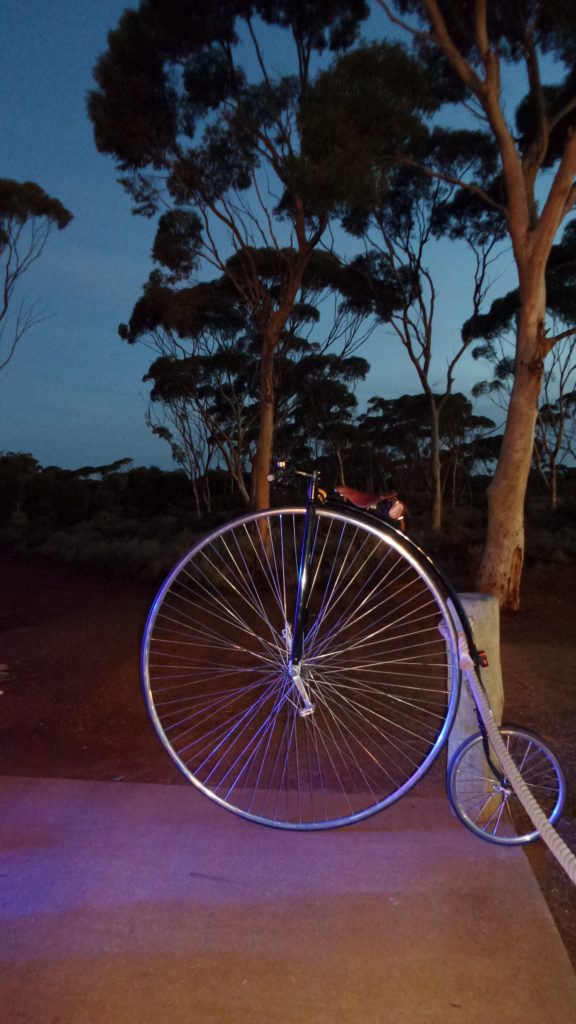
Another beautiful Goldfields sunset.
Long before the internal combustion engine found its way into a cycle frame, before the chain drive, gears or brakes, cycling was a rudimentary yet exhilarating experience. People were able to travel from place to place without the need of a horse or carriage, however, there was a catch. Early bicycles were slightly unstable, bordering on dangerous, and came with an enormous front wheel. Fortunately a fix was at hand. In the short space of about 20 years the penny farthing was phased out in favour of the safety bicycle, the most utilitarian form of personal transport yet devised.
It is for good reason the 1890s were universally known as the Golden Age of Cycling. Pneumatic tyres, brakes and the free hub were making an impact upon the development of a machine that only a few years earlier had arrived perfectly. Perfectly, because the original design has endured for over 150 years and, despite a great deal of effort to improve on the design, the diamond frame, chain-driven bicycle remains largely unchanged.
At about the time the safety bicycle was making an impact upon the pedestrian world, word was filtering back to England about untold riches that could be scooped from the red dirt of the West Australian Goldfields. Many ambitious, young men were steaming towards Australia and the next big gold-rush. One of those young men was my great-grandfather, Albert Jesse (Tommy) Talbot, 20 years of age with stars in his eyes, young Tommy was heading to Australia to make his fortune.
I love the Goldfields. I’ve spent a lot of time living and working in Kalgoorlie and I always welcome an opportunity to return. This time I was in the Goldfields for the National Veteran Car Rally but earlier in the year I went out to run the Goldfields Pipeline Marathon, a 42 kilometre footrace through the red dirt and mallee scrub, alongside the famous pipeline that has been keeping the Eastern Goldfields of WA hydrated since 1903.
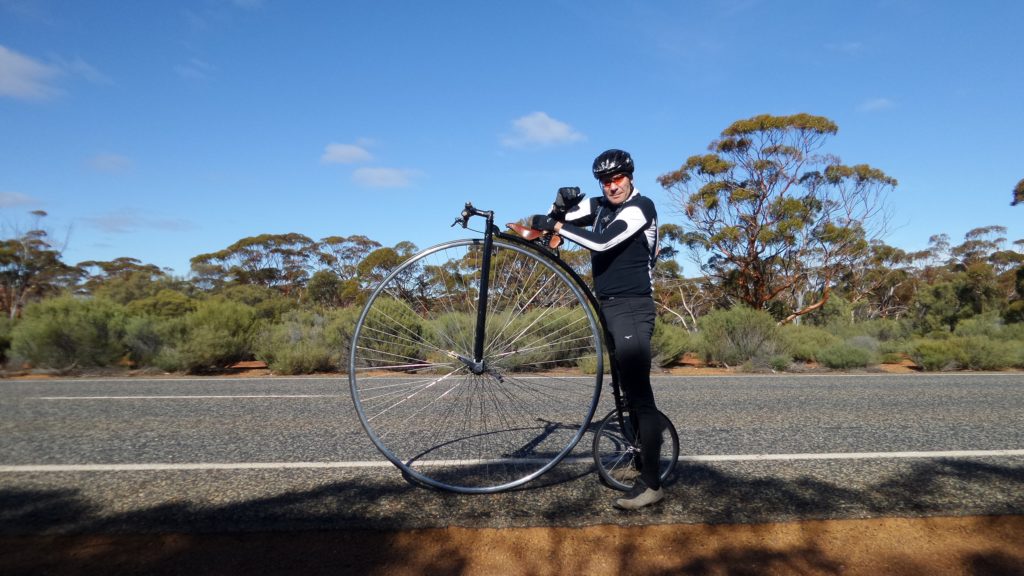
As I trundled towards the town of Coolgardie on my replica penny farthing I looked down at the bitumen, way below my feet, and felt some relief that the rough aggregate had been rolled smooth by countless trucks and road-trains. Conversely, I felt a slight pang of alarm every time I heard another one of those trucks approaching from the rear. Despite the vast amount of traffic on the Goldfields Highway, there is no reasonable shoulder to steer towards. The white line has a rumble strip and to the left of that there is, at best, about 20 to 30 cms of bitumen. On most bikes running off the hard surface onto the gravel wouldn’t be a problem but, on my 55” penny farthing, leaving the bitumen could be treacherous.
When John Kemp-Starley set about improving on his uncle’s penny farthing design his primary intent was to make something a little safer. John was able to achieve this by introducing the chain drive and bicycle wheels once again returned to the same size, front and rear, as they had been at the time of the French velocipede.
The velocipede was an ungainly machine which consisted of two wheels joined by a wooden frame with peddles attached to the front wheel. John Kemp Starley’s innovation was significant because no longer was gearing determined by the size of the front wheel, as had been James Starley’s hypothesis. James Starley’s bicycle was as brilliant as it is simple, he found that by increasing the size of the front wheel of the velocipede one could travel further with each peddle stroke. He made the driven wheel to such a size he could barely reach the peddles and, in homage to Shakespeare, Starley named his cycle ‘Ariel’ after the playful sprite in the Tempest.
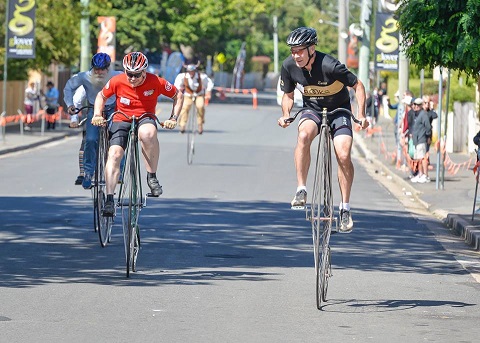
Yes, we even race these things. This was taken at the 2017 Australian Penny Farthing Championships in Evandale, Tasmania.
Riding a penny farthing comes with a great many caveats. Not the least of which is the size of the front wheel is best determined by the inside seam of the rider’s leg, the machine can only be stopped by dismounting it, the peddles are fixed, it’s impossible to raise out of the saddle and the brake should only be used when one’s weight is upon the rear mounting step because, to do otherwise, may result in the aptly described ‘header.’
In running off the road, it is the header that I’m mainly concerned with. If the wheel gets stuck on some jagged bitumen or anything else that prohibits forward momentum there is only one way to go and that’s headfirst into the ground, which is a long way down. I’ve done it before, it’s unpleasant and it plays through my mind ever time the wheel comes close to the edge of the road. But not today. Today the big wheel was turning beautifully, the sun was warming my back and I was on a roll.
When John Kemp Starley came up with his chain-drive safety bicycle the penny farthing was retro-named the ‘ordinary,’ as opposed to the ‘unsafe’ or ‘dangerous’ bicycle. Lexicon aside, I can’t help thinking a good many people must have been hurt by riding these things on unsealed roads. Another road-train and I edge as close as I dare to the side of the road.
122 years earlier, my great grandfather Tommy had also struck out for Coolgardie. In 1892 Southern Cross was the furthest town East of Perth at some 370 kms from the WA capital. Tommy teamed up with two chums (as they were called back in the days of the gold rush), Harry Baker and Dick Fosser, and headed out of Southern Cross purportedly following the trail of two experienced miners, Arthur Bailey and William Ford.
What happened when the men arrived in the area which was to become Coolgardie is the subject of much conjecture but within four days of arriving Tommy and his chums hit pay-dirt, scooping up a large amount of gold that was easily located through surface mining, or ‘napping’ as it was known. Evidently the young men kicked their knees up, hooted and hollered as they stuffed their pockets full of gold nuggets. The behaviour of the young men soon drew the attention and then the ire of Bailey and Ford who proceeded to claim the ground as theirs. Tommy protested the ground had not been pegged – only to learn Bailey was busy doing that whilst Ford held them at gunpoint. The area later became known as Fly Flat.
As I got closer to Coolgardie I could see Fly Flat from the seat of my penny farthing and marvelled at the tenacity of anyone to trek all the way out here to search for the elusive yellow metal. In running the Goldfields Pipeline Marathon from Coolgardie to Kalgoorlie, I covered much of the ground that my great grandfather would have travelled over a century before. With a clear trail through the bush and aid stations every seven kilometres or so, a long run in the goldfields can be a pleasant and rewarding experience. By the time Tommy and his mates arrived at Fly Flat the nearest aid was over 180 kilometres to the West.
A brisk headwind and a couple of stops for photographs or a drink had pushed my 38 km ride out to over two hours. My ride coincided with a veteran car rally so Coolgardie residents and tourists were out in full force as I rode into town on the big-wheel.
“Did you ride this all the way from Kalgoorlie?” was asked more than once, to which I would reply, “yes, and I’m only half way, I’m still yet to ride back.”
I visited the local museum and viewed some photographs of my great grandfather and a telegram sent by the Mining Warden in Southern Cross to Perth. This telegram reads:
To Under Secretary for Lands
A miner named Talbot in from Bailey’s find with two hundred and eighty seven 287 ounces of gold.
John W Finnerty, Warden 220. 11.10.92
The telegram lead to the largest gold rush in Australia’s history, a fact which is proudly emblazoned across large signs at each end of Coolgardie.
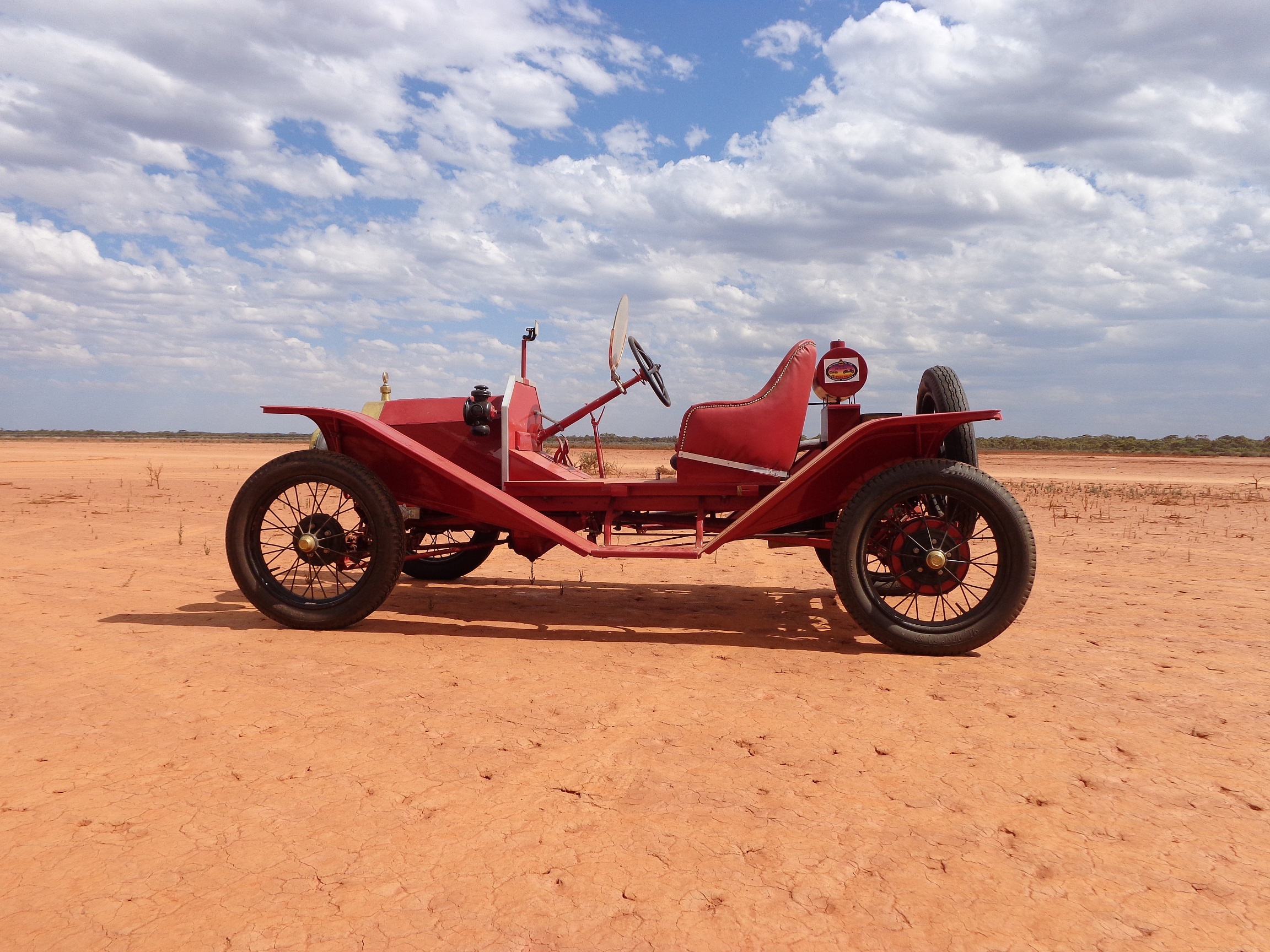
by Dan Talbot | Jan 23, 2019 | Projects
Lake Perkolilli is calling and veteran car racers from all over Australia are stepping up to the challenge. Here we look at a project by Graeme Lockhart.
Perkolilli is not exactly a household name and doesn’t quite roll off the tongue but, there was a time, over 100 years ago, that Lake Perkolilli was a unique, natural speedway enjoyed in equal measure by cars and motorcycles. Under a baking hot Goldfields sun, the dry lake bed made the perfect surface for a 4 kilometre racing circuit, “the outback’s own racetrack, the Brooklands of the West (Cocks, 2016, 471).”
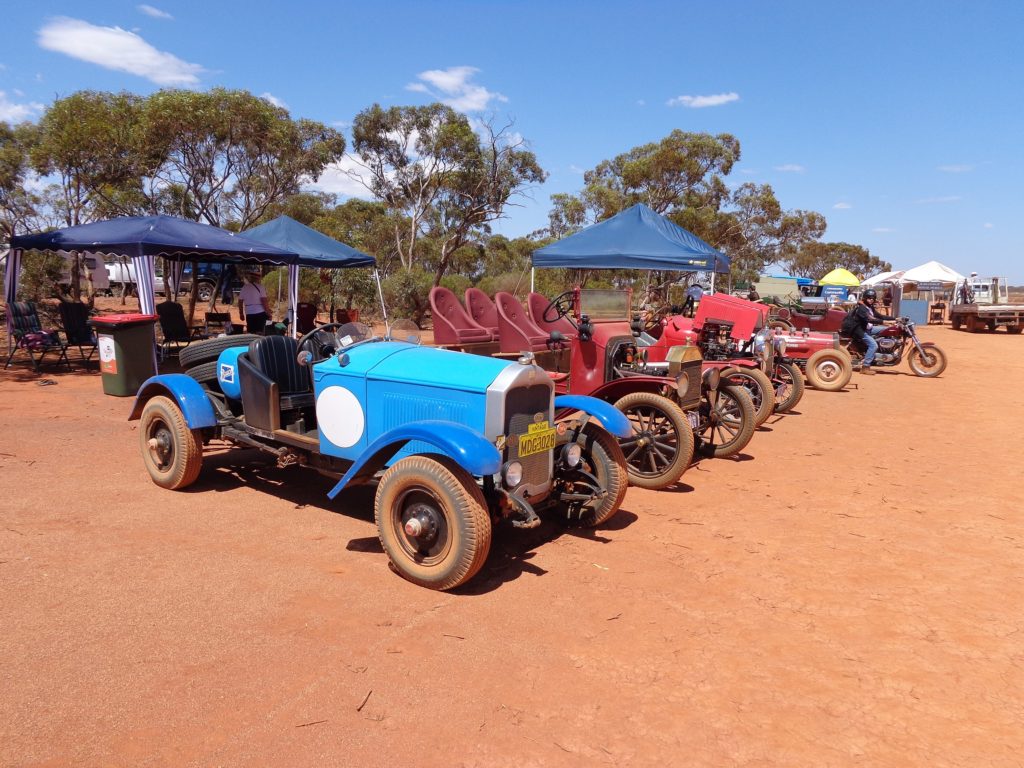
Red Dust Racers lined up waiting a turn around the 4 kilometre clay pan surface of Lake Perkolilli.
In 2014 members of the Vintage Sports Car Club of WA (VSCC) staged a Centenary of Lake Perkolilli event and we were there with the Motor Shed Model T and penny farthing in tow. Unfortunately, that event was rained out before racing got underway, but not before the early arrivals got some fast laps in. The event also coincided with the Australian National Veteran Car Rally so the week wasn’t a complete loss, quite the contrary. The cars that did get to turn a few laps gave us early arrivals a taste of years gone by and a longing for more of the same.
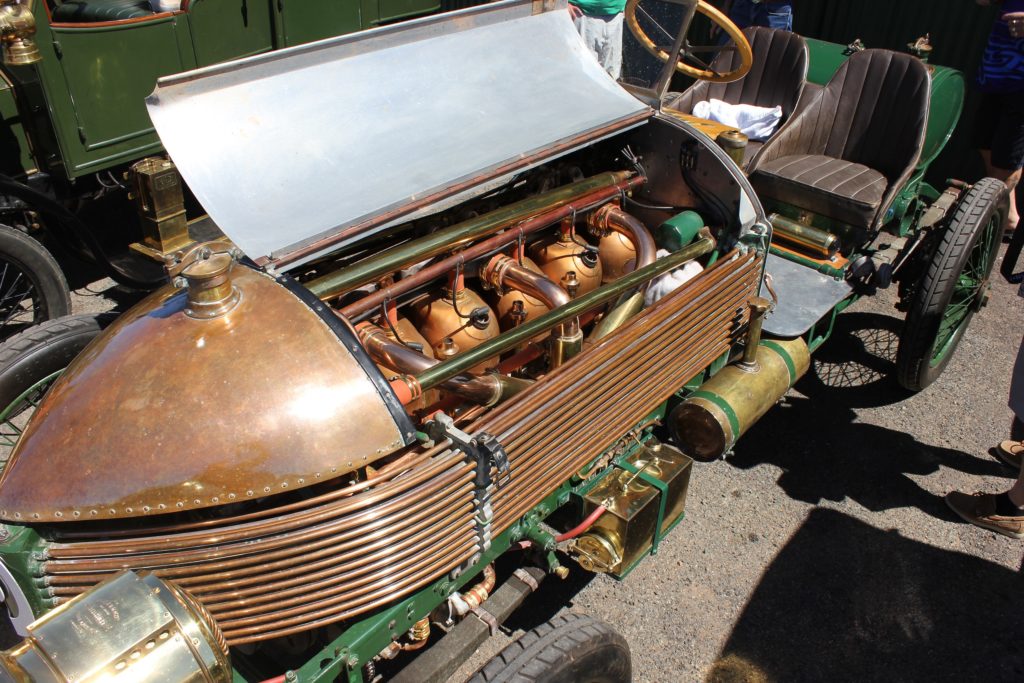
The 15 litre, 6 cylinder engine in Peter Brigg’s Napier is an impressive sight. Note the copper ‘radiator’ pipes down the side of the car.
Stung by the disappointment of not actually making it to the race weekend, the organisers have regrouped and Perkolilli is on again in 2019. Restricted to cars and motorcycles constructed before 1940 (or at least parts thereof), projects are furiously being thrown together as competitors race against the calendar in time to meet the September event. According to the Red Dust Revival update number 3, cars are being built all over Australia. Proof of some of those cars under construction is provided in the newsletter, which can be viewed here https://www.facebook.com/reddustrevival2019/
Make no mistake, these machines, in most cases, are genuine out and out race cars and motorcycles, designed to be driven hard across the clay pan, faster and faster, until the thrill of speed overcomes the fear of crashing – to borrow a term by Hunter S. Thompson.
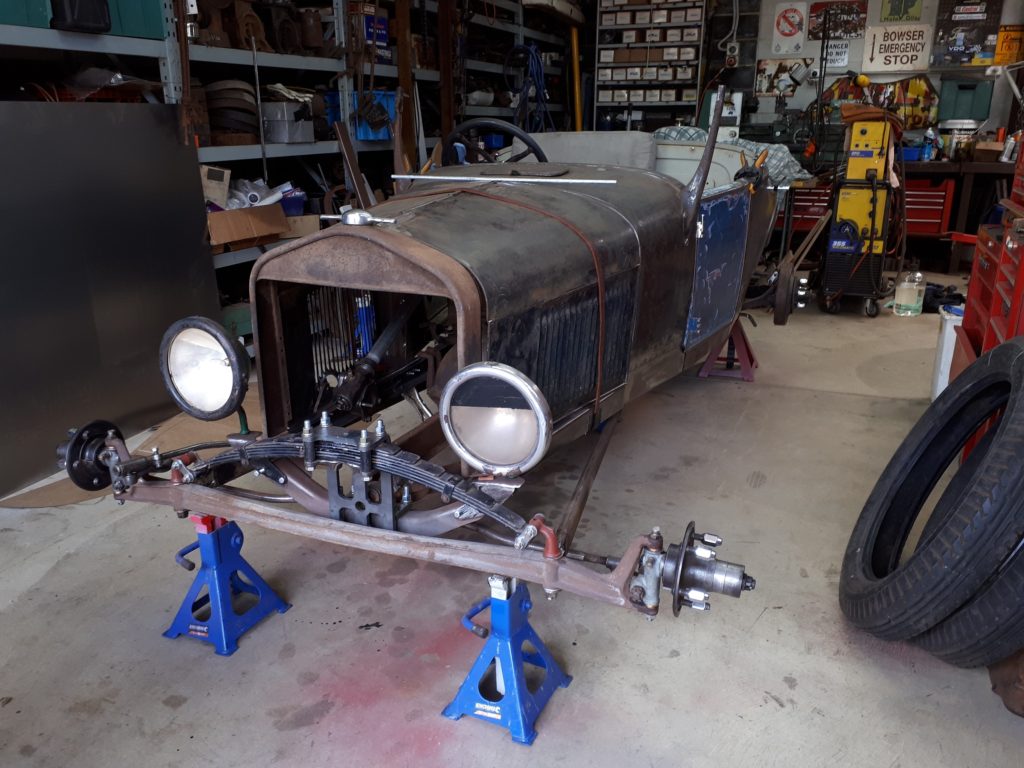
Graham Lockhart’s Model T speedster is taking shape. It promises to be another stunning example of this man’s skills in auto restoration and manufacturing.
One of those cars is a Ford Model T Speedster being cobbled together by Graeme Lockhart out of parts that he has accumulated over the paster few decades. Indeed, Graeme has enough chassis and engines tucked away in his suburban property to build three or four such race cars. We’ll call Graeme’s speedster a 1925 model as that reflects the era of the cars from which Graeme is drawing his stock.
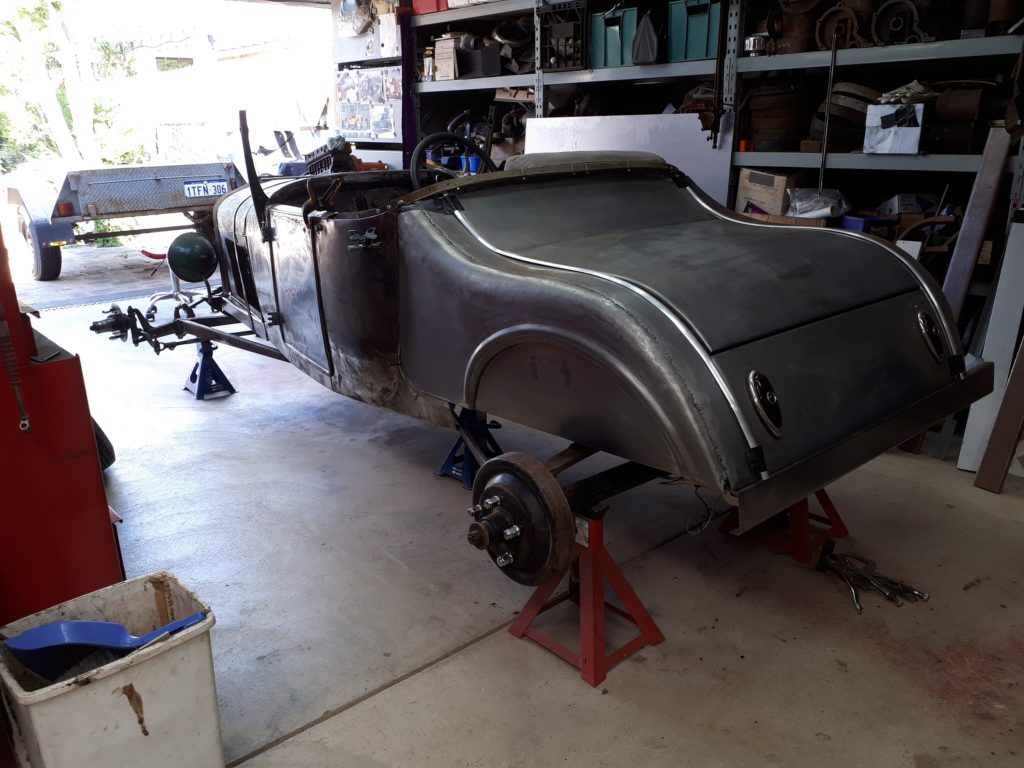
The bright metal has been constructed by Graeme using his unique CAD (cardboard added design) process.
Graeme is one of those rare individuals who exhibit both metal and mechanical prowess. His most recently competed machine is a stunning Ford T Mercury body speedster. The Mercury Body Corporation built ‘boat-tail’ speedster bodies for Model T cars from 1921 to 1926. During that time over 1,600 cars were built however it wasn’t enough to save the company from bankruptcy and they closed the doors in 1926. Graeme’s car is a reproduction built by hand from a timber buck that has more resemblance to a boat than an automobile.
Graeme’s Perkolilli racer will be powered by a 3-litre, 4 cylinder Ford engine from 1927. It is mounded on an original Model T chassis that has been lowered some 10 inches. As is often the case with projects from the distant past, Graeme only had bits and pieces of a body. For the pieces he was missing Graeme used his unique CAD (cardboard aided design) templates to first fashion the required part and fit it against the body before creating the panel in metal. All the bright metal in the accompanying photographs has been fashion by Graeme, by hand.
In returning to Graeme’s tuning skills, the engine in his Mercury T was punching out almost three times the horsepower of the original item, due, in part, to an after-market Rajo head, twin down draft Stomberg caburetors and Graeme’s own headers, once again built by him by hand. An A Model crankshaft was modified to fit the old T block, the intention being to withstand the increased power. The engine kept popping head gaskets so, in the interests of reliability and longevity, it has been returned to a standard head and single carb but I suspect Graeme’s not done with power-plant just yet.
Graeme has started on renewing the engine block for his Perkolilli car but it’s early days. We will check in with him over the coming months and, of course, will be there when this beauty takes to the red clay pan at Lake Perkolilli.
Anyone wanting to learn more about Perkolilli and historic motor racing in Western Australia might like to consider obtaining a copy Graham Cocks stunning limited edition “Red Dust Racers.” The book can be purchased directly from the author at www.motoringpast.com.au
